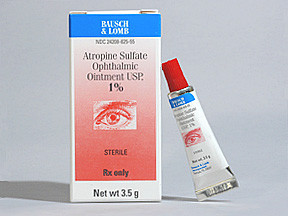ATROPINE SULFATE OINTMENT - OPHTHALMIC
PHONETIC PRONUNCIATION: (AT-roe-peen SUL-fate)
GENERIC NAME(S): atropine sulfate
Uses
USES: This medication is used before eye examinations (e.g., refraction) and to treat certain eye conditions (e.g., uveitis). It belongs to a class of drugs known as anticholinergics. Atropine works by widening (dilating) the pupil of the eye.
How to use ATROPINE SULFATE OINTMENT - OPHTHALMIC
HOW TO USE: To apply eye ointments, wash hands first. To avoid contamination, be careful not to touch the tube tip or let it touch your eye. Tilt your head back, look upward, and gently pull down the lower eyelid to make a pouch. Place a 1/4 inch (0.5 centimeter) strip of ointment into the pouch. Gently close the eye and roll the eyeball in all directions to spread the medication. Try not to blink and do not rub the eye. Repeat these steps for your other eye if so directed. If you are using this medication on a regular schedule, apply as often as directed by your doctor, usually 3 times daily. Do not use the ointment if it has changed color. Wipe the tip of the ointment tube with a clean tissue to remove extra medication before recapping it. If you are using another kind of eye medication (e.g., drops or ointments), wait at least 5-10 minutes before applying other medications. Use eye drops before eye ointments to allow the drops to enter the eye. If you are using this medication on a regular schedule, you can get the most benefit from it by not missing any doses. To help you remember, use it at the same times each day. Continue using it for the full time prescribed. Inform your doctor if your condition does not improve or if it worsens.
Side Effects
Precautions
Interactions
Overdose
Images
Reviews
Faq for ATROPINE SULFATE OINTMENT - OPHTHALMIC
Atropine Sulfate Ointment - Ophthalmic is used to dilate the pupil of the eye and relax the muscles of the eye.
You should wash your hands before applying the ointment. Gently pull down the lower eyelid to create a small pocket and apply a thin strip of ointment inside the lower eyelid. Close your eyes and roll your eyeball in all directions to spread the ointment.
The frequency of use depends on the specific instructions from your healthcare provider. Typically, it is applied once a day at bedtime or as directed by your doctor.
Common side effects may include blurred vision, sensitivity to light, dry mouth, and increased heart rate. These side effects are usually temporary and should subside over time.
Yes, Atropine Sulfate Ointment - Ophthalmic can be used in children. However, the dosage and frequency of use may be different for children compared to adults, so it is important to follow your healthcare provider's instructions.
It is recommended to remove contact lenses before applying the ointment, as it may affect the fit and comfort of the lenses. You can reinsert your contact lenses 15 minutes after applying the ointment.
The onset of action can vary, but typically it takes about 30 minutes to an hour for the ointment to start working. The effects can last for several hours.
It is essential to consult with your healthcare provider if you are pregnant or breastfeeding before using Atropine Sulfate Ointment - Ophthalmic. They can weigh the potential benefits against any potential risks to determine if it is safe for you to use.
If you accidentally ingest the ointment, seek medical attention immediately. Ingesting atropine can lead to serious side effects, and it is important to get professional help as soon as possible.
Disclaimer
IMPORTANT: HOW TO USE THIS INFORMATION: This is a summary and does NOT have all possible information about this product. This information does not assure that this product is safe, effective, or appropriate for you. This information is not individual medical advice and does not substitute for the advice of your health care professional. Always ask your health care professional for complete information about this product and your specific health needs.

No Reviews Yet